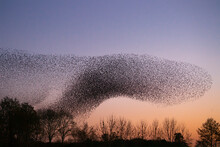Starlings
by Ryan Krzykowski
 If you’ve never seen a starling murmuration, you might want to check this out. It is beautifully fascinating to watch hundreds of these birds move as a single unit. How is it even possible for so many distinct creatures to coordinate their actions so quickly and precisely? It’s like a perfectly executed play, in which each member of the team handles their responsibility just right, down to the smallest detail. Except in this particular play the birds haven’t practiced, can’t use words, and are flying around in the air at high speeds. It’s absolutely incredible.
If you’ve never seen a starling murmuration, you might want to check this out. It is beautifully fascinating to watch hundreds of these birds move as a single unit. How is it even possible for so many distinct creatures to coordinate their actions so quickly and precisely? It’s like a perfectly executed play, in which each member of the team handles their responsibility just right, down to the smallest detail. Except in this particular play the birds haven’t practiced, can’t use words, and are flying around in the air at high speeds. It’s absolutely incredible.
I became aware of starlings and their flock formations while reading The Culture Code by Dan Coyle. Coyle writes of a 2007 study from the University of Rome that demonstrates how the birds do what they do.
Basically, each starling tracks the six or seven birds closest to it, sending and receiving cues of direction, speed, acceleration and distance. That shared habit of intensive, up-close watching, amplified through the flock, allows the group to behave as one.
Coyle connects this idea to human behavior and performance — suggesting that effective environments consistently, repeatedly provide group members with “small, vivid signals” that serve as “the two simple locators that every navigation process requires: Here is where we are and Here is where we want to go.” When this type of ongoing communication is woven into the fabric of a group or team, when collective goals or ideals are continually emphasized and prioritized, people tend to respond. We want to do our part to help the group achieve the goals we’ve established together. As Joe Ehrmann puts it, we need each other and we affect each other.
I know this much — the next team I coach is going to watch some starling video and we’ll talk about what we can learn from the birds that will make us better teammates and coaches.
Let’s Coach With Purpose…

Isn’t that a beauty full sight, the Starlings Dance. Imagine for a moment, amplified, behaving as one, doesn’t that bring up the picture of heaven, becoming like one, one in Jesus, the God U and I Dance. Where is the dancing and the joyful voices, i think of the music the Starling hears, the music he is actually dancing to, following the perfect one, the holy spirit leads the birds, isn’t it true, they have no food, they have no job, no field, and God cares for them, imagine the DANCE we can do when we give him everything, every fear, every promo, every worry and every doubt. Different, we want to be different, difference makers have to be different! We dance to a different set of music, heaven all around. Think about the humming bird, the Starling, they sure don’t mind being different, when the bird sings in the morning, why does he sign, he opens up the doors, creation wakes up, the flowers wake up to the sound. Make a sound for Jesus today!